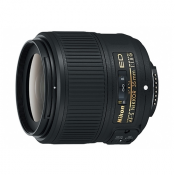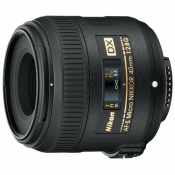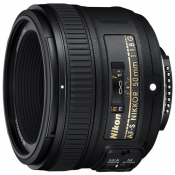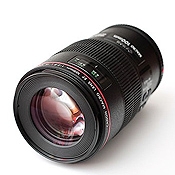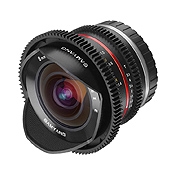Nikon 35mm f / 1.8G AF-S DX Nikkor
Short review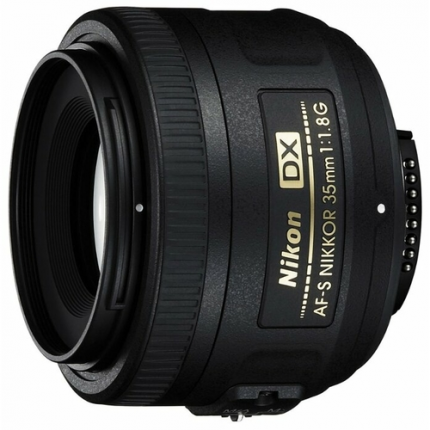
Selected in the rating
5
Best rating
lenses for Nikon cameras
Autofocus - Built-in Motor - Mount: Nikon F - Type: Standard
Buy Nikon 35mm f / 1.8G AF-S DX Nikkor
Nikon 35mm f / 1.8G AF-S DX Nikkor Specifications
Yandex.Market data
| Main characteristics | |
| Lens type | standard |
| Focal length | 35 mm |
| For non-full-frame cameras | Yes |
| Diaphragm | F1.80 |
| Minimum aperture | F22 |
| Mount | Nikon F |
| Focusing motor | there is |
| Auto focus | there is |
| Design | |
| Number of elements / groups of elements | 8 / 6 |
| Aperture blades | 7 |
| Dimensions (D x L) | 70 x 52.5 mm |
| Weight | 200 g |
| Shooting options | |
| Viewing angle | 44 deg.min |
| Closest focusing distance | 0.3 m |
| Additional Information | |
| Ultrasonic motor | there is |
| Filter thread diameter | 52 mm |
Opinions from the Nikon 35mm f / 1.8G AF-S DX Nikkor
Yandex.Market data
Advantages:
Lightweight and compact, convenient focal length for DX, almost silent focusing, decent picture quality already at open aperture, not a bad design for this price.
Disadvantages:
Slight play in the focusing ring (within 0.5 mm). Noticeable CA and barrel distortion of the picture. Rough pattern in the out-of-focus area (if this is critical, it is advisable to cover the aperture by about half a stop).
Comment:
An excellent expensive prime mount for Nikon DX format SLR cameras. Especially great as a flavoring for small DSLRs like the D40, D40x, D60 or D3000: this combination is similar in size to a large super duper zoom compact. At the same time, the camera does not "bite its nose" when hanging on a belt. Compared to the stock 18-55 VR, this lens seemed much less flimsy: nothing dangles, doesn't slide out, and doesn't suck on dust. Pleased with the metal bayonet with a rubber seal. In terms of sharpness, my D40 has no complaints, even at open aperture. The existing flaws of the picture either do not strain, or are removed in a RAW converter.
13 May 2010
Advantages:
I bought a lens as a room portrait to replace the whale 18-55 (take a picture of a child and a wife, of course: D), well what can I say, just the earth and the sky, my wife was delighted and said - "this is exactly what I wanted from a DSLR ". The photos are very sharp with beautiful bokeh, plus the process itself becomes more interesting, the depth of field at the minimum focal length is probably 5-6 centimeters, then the blur begins, I started to use manual settings intensively, the creative process started! If the whale lens is on the car, that in the manual mode is almost the same result, then there really is where and with something to experiment.
Disadvantages:
Didn't find it. Perhaps you don't have enough experience or haven't tried something better, but the only drawback of this lens is that the whale lens is now gathering dust in a case ...
Comment:
I bought the D3100 kit Af-S DX 18-55 VR, now I regret not taking the body + 35mm f / 1.8G AF-S D right away, don't step on my rake;)
26 March 2012
Advantages:
optically sharp, lightweight, small, metal bayonet, comfortable focusing, quiet autofocus, price, "native" Nikon
Disadvantages:
Occasionally, a not very beautiful blur of the background is obtained, somewhat motley, dazzling in the eyes
Comment:
I took it as the first and only lens for a DSLR, for several months I shot only with it, then I used other lenses, but this one remained my favorite, most of all I like the picture from it.It met expectations by 100%, you can shoot almost anything, including in low light. Although a wide angle is not enough for urban landscapes and confined spaces, it is almost always possible to take a picture (unlike 50mm, which turns into 75mm on the crop.) I think that I must be in the arsenal of any novice photographer. Ideal for walking around the city, when you don't know whether you will be shooting or not and just want the camera to be at hand - small and light, with it the camera on the strap does not outweigh the lens downward.
August 27, 2010
Advantages:
- Sharpness, in comparison with the whale 18-55 at equal apertures, the details are worked out much better, the micro-contrast is quite good (due to the better resolution), the sharpness at the edges of the picture at small apertures almost does not drop. - Aperture: the ability to shoot in poor lighting conditions and indoors without a flash (for ISO 200 and acceptable shutter speeds, not a bright light from the window is enough). This also includes the creative opportunities that a small depth of field provides. - Nice bokeh. Of course, this is a matter of taste, but I like the background pattern. At small apertures, it is good to shoot portraits, mack up with plants. - Metal mount (reliability). - When focusing, the lenses move inside the lens, nothing comes out outside and, accordingly, sucks dust less. The front lens does not rotate - you can put a polarik. - Price. 6,700 rubles - just ridiculous (this is how much the purchase came with delivery from a foreign online store).
Disadvantages:
- Still, not all the details fit perfectly. However, this is the fault of all available Nikon lenses (even those that initially work well - after half a year of operation they get a little loose). You just need to be more careful with it - and it will last for many years. - A small "barrel". Conditional flaw. Firstly, it can only be noticed in specific photographs, and secondly, it can be easily corrected in the appropriate editors. - Slight chromatic aberration. Also conditional. Sometimes they give an additional artistic effect. Most modern Nikon models are retracted automatically. Also cleaned up in photo editors.
Comment:
Great lens. Small, with a beautiful picture. Light. Cheap. Well suited as a regular one. But! We must be aware that this is a fix: you should take it only if you want to experiment creatively at small apertures, and being completely sure that this focal length is suitable.
April 9, 2011
Advantages:
1. Aperture ratio (in conditions when it would be impossible to read a book - he shoots like during the day, though at ISO 1600 and above, and the shutter speed is around 1 / 5-1 / 10 sec.) But the picture is quite smooth, without much noise. 2. Size, very compact even with a hood, after 18-200 it seemed that there was simply no lens))) 3. Perfectly washes the background (bokeh) and creates a feeling of airiness throughout the photo. At the same time, in the focus zone, it is sharp, I would say NATURALLY sharp, without artificiality and excesses, but I did not notice the soap. 4. I think that these focal lengths (35 mm) are the golden mean and the so-called "staff" for the crop (I put it on d7000). 5. Focuses already 15 cm from the front lens (although the description indicates 30 cm) and gives a very good picture, comparable to fixes (if 1x2 meters are not going to print an image of a ladybug or flower). But you need to know that when shooting an object from a distance of 15-20 cm. At 1.8 aperture there will be about 1 mm of depth of field, so if you want bugs, spiders, flowers or jewelry to be completely in the field of focus, you need to compress the aperture to f / 6 or more! 6. Excellent compact and durable hood. 7. 7-blade diaphragm (nice circles in boke).8. Small filter diameter (52 mm), respectively, not expensive UV filters and others. 9. USM is more like an advantage (but personally I think that at 35 or 50 mm it doesn't matter, because usually they don't remove the dynamics, so a screwdriver wouldn't be a problem either). 10. Metal mount. 11. There is NO vignetting on my copy from 1.8 onwards.
Disadvantages:
1. Does not photograph himself. Otherwise, everything is expected and there is nothing to criticize here. 2. The only pity is that it does not fit a full frame, on the other hand, you can sell it together with a carcass, a set. It is also an option. 3. AF really misses plus or minus 1-2 cm, but on a narrow depth of field like 1.8 or even 2.8 you obviously will not shoot figure skating, boxing or running kids (too narrow depth of field, in my opinion, for such tasks), so for leisurely shooting is fine.
Comment:
Performs its tasks, did not reveal jambs. DOF at 1.8 from a distance of 1 m to the subject is equal to literally a few millimeters, at a distance of 2-3 m, probably 1-2 centimeters, due to which it seems that the whole image is out of focus, but this strip of sharply depicted space is very clear goes like a saw cut through a tree through the entire image. Very impressive. Of course, if there is an object in the focus area, everything is great, airy, perfectly draws and washes the background (boke). Comparing it with the 35mm f / 2D AF Nikkor (I see no reason to compare it with 50mm, since 50mm gives too narrow an angle on the crop (75mm in fact), then f2 and AF (instead of AF-S) are clearly not in 35mm f / 2D AF Nikkor is beneficial, and its price is 2-3 thousand more. I have already spoken about USM - I think that this is of course a plus, but screwdrivers do not rattle all over the area, as many probably think. there is nowhere too much for 35 mm fix. Well .. let's just say, zooming with your feet will take longer than this baby focuses. A case from life. recently a Mazda, acceleration to 100 km in 4 seconds! Yes, there was an opportunity to buy 100 thousand cheaper, but there acceleration to a hundred in just 6 seconds ... ", to which another friend of mine reasonably replies:" Indeed, what would you do in those extra two seconds ?! "...)) So look at everything wisely and not chase the" best ", if in fact it only takes a few thousand extra from your pocket but in practice it is not really necessary ... Good shots everyone! I hope I helped to decide on something.
23 january 2013
Advantages:
- luminosity - price (bought in a well-known online store, with delivery to my city, something came out about 8 tr.) - light and compact - metal mount - versatility
Disadvantages:
- autofocus misses in low light conditions - creepy to put on / remove the hood (the force on the latch is significant)
Comment:
Nikon 35mm f / 1.8G AF-S DX is my first prime. I decided that if the camera is "initial" (Nikon D3000), then the optics will be for beginners. Only this wonderful objectivist is quite an "adult" !!! Yes, by no means top-end glass, but in terms of picture quality and build quality, the lens is quite good. The first photos from him delighted children (before that only the whale was 18-55). I was looking for a fast lens for comfortable shooting indoors without a flash. The most affordable bright zoom would cost about 2 times more. Why 35 and not 50? Everything is simple here. I sorted the successful shots (with the whale) by FD - most often I used FD of about 35. In fact, this focal length is very convenient - as you see, you shoot. At 1.8 DOF is very small - I had to get used to it. On an open aperture, the image is soft (well, someone will say "soap"), sharp somewhere from 2.8 -3.2. We were disappointed only by AF misses, in poor or artificial lighting (about a quarter of all shots are ejected for this reason). On the street - everything is in order. Someone complains about chromatic aberration - there is, but very good.minor ones are corrected instantly in lightroom, as well as minor geometric distortions. I won't recommend it to beginners precisely because of the "adult behavior" of the lens - first you need to understand what depth of field is, master at least semi-automatic modes, and then you can switch to this fix. Summary: if you understand the difference in modes A, S, M, and you want to get the most out of your amateur DSLR - this lens is a must for purchase. Moreover, now it costs more than adequate 7t.rub
5 June 2012
Advantages:
Quite good build, although China. Nice package bundle: the lens itself, a case and a hood. Size and weight. Now you can easily carry it in your bag, without worrying that a bulky lens will rest on the side, pull your shoulder down or make the camera "nod off" around your neck. Excellent aperture at open aperture. Very nice bokeh. Image quality: with a slightly covered hole, photos are surprisingly sharp; color rendering is also pleasing to the eye. The focal length is very convenient for universal purposes - it turns out about the same as we ourselves see it. For me personally, fifty dollars would be too much. Autofocus with manual adjustment.
Disadvantages:
Autofocus is often blurry. Strong back focus. Chromatic aberrations. Some pictures show a purple halo.
Comment:
I took it to Nikon D3100 - now the whale lens is gathering dust in the bag, I have never changed this charm. As a staff for DX cameras - the very thing. Adequate price / quality ratio. I am completely satisfied with the photos and the lens performance.
October 9, 2012
Advantages:
1. Lightweight and small. 2. Hood included (although it does not help often). 3. Aperture ratio. 1.8 is quite a working diaphragm. 4. Can be used as a staff thanks to the suitable angle. 5. Extremely cheap. 6. Very fast autofocus. 7. High sharpness, perhaps even higher than Nikon's 50 1.8 D.
Disadvantages:
Considering the price, there are no downsides to the lens. Plasticity does not detract from its durability, lenses with focusing problems are not so common, and the fact that with a protective filter it desperately glares is completely solved by removing the filter.
Comment:
The lens showed itself well on two of my carcasses - d5100 and d80. The focusing speed on both is high, the sharpness throughout the frame, the bokeh is decent. The camera with it does not look like a terribly cool mega-mirror, if anyone cares. But even in comparison with the whale, the dimensions are noticeably reduced. This, of course, is not a 40mm Canan pancake, which looks more like a plug for a bayonet, but it is still very small. The hood can be twisted into the stowed position without any problems. The lens is solid, manual focusing is comfortable enough, autofocus is flawless. Perfect as a replacement for the whale on the first DSLR. It will teach you how to work with a tiny depth of field and make you delve deeper into photography. On the other hand, even on the machine, it produces frames of very decent quality. Be careful with protective filters - they glare indoors. For those who are not yet very sophisticated in photography and choose between 50mm and 35mm, I would still recommend 35 if you do not have a clear goal to make mostly portraits. The angle of view is very noticeably different from 50 mm. 35mm is the same as 50mm on a full-frame DSLR, which means you have a classic fifty. All good shots.
November 27, 2013, Tver
Advantages:
sharp, relatively cheap, does not creak. Almost completely coincides with the angle of human vision (on the crop), which simplifies the selection of a frame without a camera.
Disadvantages:
Chromatic aberrations on a large hole (programmatically treated). Probably still distortion, but in ordinary life it is not noticeable, only during testing (it is also treated programmatically)
Comment:
Either I am very very lucky, or the lens is scared of the tripod, but the autofocus miss, especially on a big hole IMHO, is not the problem of the lens, but of the photographer. When shooting handheld, it is very difficult to keep the camera completely motionless, and given the depth of field equal to 1-2 centimeters with a large hole, the shift of the camera between focusing and the picture itself gives the very same miss. A shift of 1-2 centimeters is almost imperceptible for the photographer. And then the photographer will be pulled, either backward or forward. All lenses may not be defective, before you scold the glass, check the curvature of the hands
August 4, 2013, Arkhangelsk
Advantages:
Lightweight, compact, looks good on d5100. I took 18-55 for portraits as an addition to the whale, but in fact abandoned the whale altogether, because in all respects, except for the viewing angle, this 35mm is much superior to the whale. When compared with a whale, the aperture is about 35mm 7 times higher (you can shoot at 100 iso with the same shutter speeds as with a whale at iso 800 under the same conditions), gives much better background blur than a whale, focuses many times faster and more exactly. The percentage of sharp shots with this lens is incomparably higher than with the 18-55, which is actually pleasantly pleasing, because at 1.8 aperture the depth of field is much shallower than at 4.5 (whale aperture at 35mm).
Disadvantages:
viewing angle. but this is not a drawback, but a feature. you just need to understand that you cannot take panoramic pictures. you need to have a different lens for this
Comment:
Previously used as an addition to the whale, now it always stands as a regular one. People write a lot about curve autofocus. Here we must remember the materiel. Put any depth of field calculator, like DoF Calc, on your phone and see this. If you shoot an object from a distance of 2 meters, then the field of focus is only 20 cm. That is, from the point of focus it is only 10 cm in both directions. If between the moment of focusing and the click of the shutter you (or the subject) have moved 10 cm, then everything is already blurred. And this is not a lens jamb, but just a feature that you need to know. So, for example, it will not be possible to photograph a person on a swing with an aperture of 1.8 in standard autofocus mode (not tracking). To make it clear, it is generally unrealistic to shoot with cool lenses for FX from 2 meters. For example, at 85mm f / 1.2, the depth of field from 2 meters is only 4 centimeters! That is, if you focus on the tip of the nose, then the cheeks are already smeared. And if you swayed a little, then in general the whole frame is in soap. And is that a bad lens?
July 22, 2015, Monino
